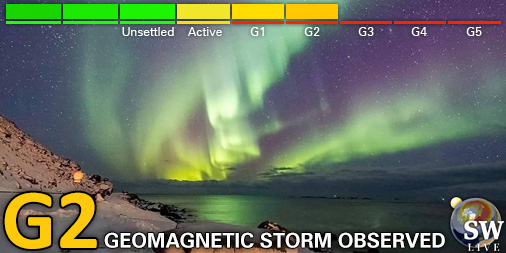Viewing archive of Friday, 2 March 2018
Daily bulletin on solar and geomagnetic activity from the SIDC
Issued: 2018 Mar 02 1230 UTC
SIDC Forecast
Solar flares
Quiet conditions (<50% probability of C-class flares)
Geomagnetism
Quiet (A<20 and K<4)
Solar protons
Quiet
| 10cm flux | Ap | |
|---|---|---|
| 02 Mar 2018 | 067 | 008 |
| 03 Mar 2018 | 067 | 008 |
| 04 Mar 2018 | 066 | 006 |
Bulletin
During last 24 hours several B-class and one C-class flare were reported. All the flaring activity originated from the Catania sunspot group 73 (NOAA AR 2007) which is presently situated rather close to the west solar limb. The strongest C1.9 flare peaked at about 11:07 UT today. The coronagraph observations show that the CMEs associated with reported flares were mostly narrow and rather slow and will therefore not arrive to the Earth. During last 24 hours solar protons remained at background level.
The Earth is presently inside the slow solar wind with the speed of about 350 km/s, and the interplanetary magnetic field magnitude is 4 nT. We might expect increase of the solar wind speed in the coming hours, associated with the coronal hole which reached central meridian in the morning of February 26. The geomagnetic conditions were quiet during last 24 hours and we expect quiet to unsettled geomagnetic conditions in the coming hours.
Today's estimated international sunspot number (ISN): 010, based on 03 stations.Solar indices for 01 Mar 2018
| Wolf number Catania | /// |
| 10cm solar flux | 067 |
| AK Chambon La Forêt | 014 |
| AK Wingst | 010 |
| Estimated Ap | 007 |
| Estimated international sunspot number | 000 - Based on 13 stations |
Noticeable events summary
| Day | Begin | Max | End | Loc | Strength | OP | 10cm | Catania/NOAA | Radio burst types | |
|---|---|---|---|---|---|---|---|---|---|---|
| None | ||||||||||
Provided by the Solar Influences Data analysis Center© - SIDC - Processed by SpaceWeatherLive
All times in UTC
Current data suggests there is a moderate possibility for aurora to appear at the following middle latitude regions in the near future
SurgutCurrent data suggests there is a slight possibility for aurora to appear at the following middle latitude regions in the near future
Kazan, Perm, Yakutsk, YekaterinburgLatest news
Latest forum messages
Support SpaceWeatherLive.com!
A lot of people come to SpaceWeatherLive to follow the Sun's activity or if there is aurora to be seen, but with more traffic comes higher server costs. Consider a donation if you enjoy SpaceWeatherLive so we can keep the website online!

Latest alerts
17:00 UTC - Geomagnetic activity
Moderate G2 geomagnetic storm (Kp6) Threshold Reached: 16:34 UTC
15:30 UTC - Geomagnetic activity
Minor G1 geomagnetic storm (Kp5) Threshold Reached: 15:20 UTC
14:30 UTC - Geomagnetic activity
Strong G3 geomagnetic storm (Kp7) Threshold Reached: 14:18 UTC
13:30 UTC - Geomagnetic activity
Moderate G2 geomagnetic storm (Kp6) Threshold Reached: 13:21 UTC
13:18 UTC - Hemispheric Power Index
The OVATION model predicts the Hemispheric Power Index to reach 125GW at 14:01 UTC
Space weather facts
| Last X-flare | 2025/03/28 | X1.1 |
| Last M-flare | 2025/04/15 | M1.2 |
| Last geomagnetic storm | 2025/04/15 | Kp6+ (G2) |
| Spotless days | |
|---|---|
| Last spotless day | 2022/06/08 |
| Monthly mean Sunspot Number | |
|---|---|
| March 2025 | 134.2 -20.4 |
| April 2025 | 124.1 -10.1 |
| Last 30 days | 124.7 -16.6 |






